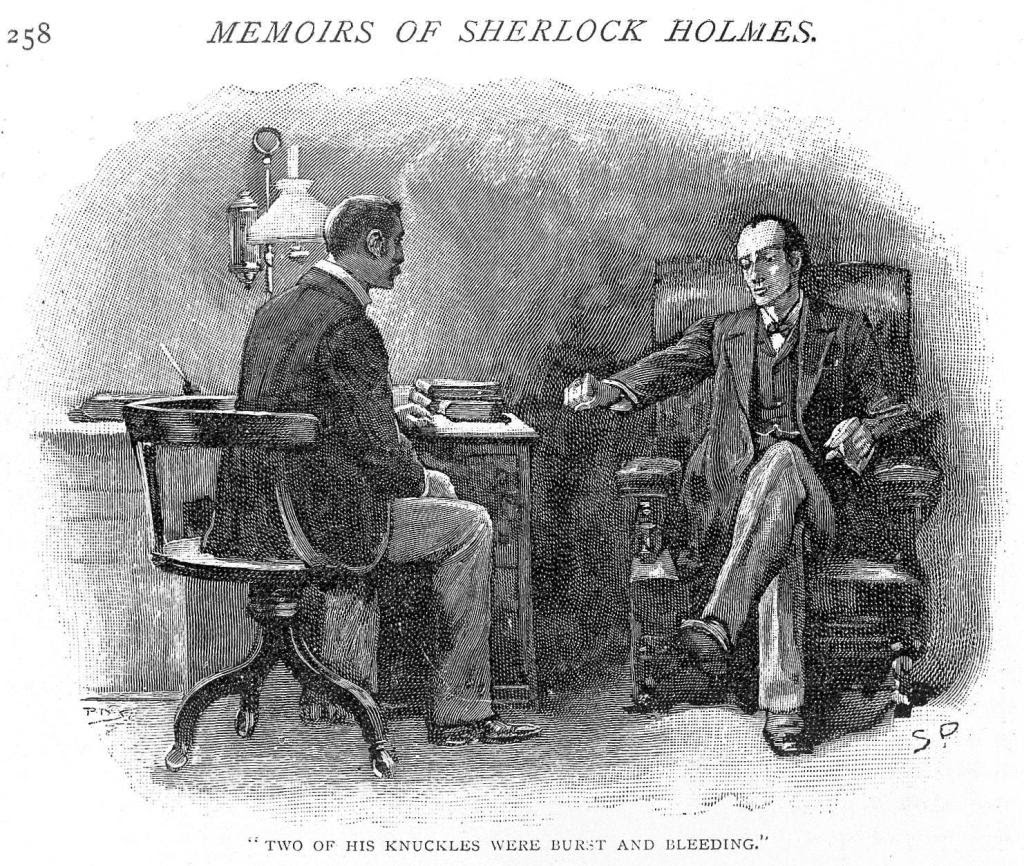
The Hound of the Baskervilles
Examine close reading of The Hound of the Baskervilles: Another Adventure of Sherlock Holmes with textual references and critical perspectives.
Arthur Conan Doyle’s crime novella is a canonical work of speculative fiction and detective literature that explores the hellhound of the Baskerville legends as a diabolical agency, huge creature, luminous, ghastly, spectral devil phosphorus painted baying werewolf spirited beast haunting the legacy of Baskerville estate and suburbians of Dartmoor Grimpen mire. In reality the mystery behind this superstitious supernatural phenomenon is a death entrapment laid down by Rodger Baskerville II in the disguise of Jack Stapleton. However the antithesis of superstitious mythicism is shrewdly contested by the skeptical detective Sherlock Holmes, and thus supernatural gothicism is challenged to the core of realistic cosmos. Selden, the absconded convict, kinsman to the Barrymores, is suspiciously implicated for his fiendish notoriety of Notting Hill case “ferocity of the crime” and “wanton brutality of the assassin”; but lately acquitted from allegation through befallen excruciating death perpetrated by the baying hound. “Barren waste moors, chilling winds and darkling skies” foreshadows saturnine funebrial macabre as envisioning of the literature of gothicism and foretelling chronicles of sublime detective fiction.
The popularity of the impeccable detective hero Sherlock Holmes foregrounds intuitive logic, astute observations, perspicuous inferences to reveal the murder mystery of the heir to the Baskerville fortune in The Hound of the Baskervilles. Diabolical supernatural agency of the hellhound is a core paradox fabricated within the threads of this occultist murder mystery. Sherlock Holmes cast as the voice of reason and rationality to challenge the swashbuckling psychorama. In this detective fiction, archetypal plot twists occur along with the progression of the storyline, in anticipation of a reverse chronology, in which the murder mystery of Charles Baskerville is committed surrounding a close circle of suspects before a gradual reconstruction of the past. Contemporaneous detective novels of Arthur Conan Doyle is diversified canon of hybridized and fluid genres involving stereotyped characters within middle class family settings, duelling and feuding in all likelihood for identity and individuality, vindictive salvation and retributive justice, freedom and equality, importance of knowledge and the discovery of buried family ties. Central characters and formal elements of the Hound of Baskervilles is a conglomeration of thrill, mystery, suspense, horror, terror, spookiness, creepiness, grisliness and wonder. However, unlike Gothic literature, wonder and terror of the supernatural, fantastic and romantic worldview: suspension of disbelief is silhouetted into obscurity; ie, the murder mystery spectacle of Gothic tradition. Afterall, the real monsters weren’t the supernatural beasts of legends but the darkness hiding within human hearts.
Howcatchem and whodunit of the Devonshire is interwoven by scientific empiricism and human psychology, bringing to the fore: epistolary chronicles between duo Holmes and Watson; weathering the taste of time; entrenched within themes, motifs, settings and psyches of Victorian England. Sherlock and Watson formulated after all, Rodger staged as Stapeton in order to get rid of the competitor rivals to the family estate and legacy of Baskerville fortunes. However, the fin-de-siecle of the prophetic rhetoric implied in the diction of Dr. James Mortimer is lucid and succinct, “there is a realm in which the most acute and most experienced of detectives is helpless.” The shoplifting of money in South America by Rodger as the imposter Vandeleur of preparatory educator of East Yorkshire and entomology research fellow of the Museum is the retrospective foreshadowing of the modern detective fiction. Jack Stapleton is the aftermath of his wedding with Beryl Garcia in Costa Rica and simultaneous settlement in England upon the voyage home. Vandeleurs occupied the Fraser’s fortune and eventually sank from disrepute to infamy. Fallaciousness of the specious identity of Vandeleur and/or Jack Stapleton alongwith the baronet’s ‘mastiff hellhound’s flaming jaws and blazing eyes’ limelights fin-de-siecle detective masterpiece.
Further Reading, References, Endnotes and Podcasts
The Hound of the Baskervilles pp. 75
Chapter Title: In the Closet of Sir Arthur Conan Doyle: The Private Life of Sherlock
Holmes (1970), Book Title: A Foreign Affair, Book Subtitle: Billy Wilder’s American Films, Book Author(s): Gerd Gemünden, Published by: Berghahn Books. (2008)
Studies in the Literature of Sherlock Holmes, Robert Knox, Bluebook, Oxford lectures, (1910)
Introduction: What is Crime Fiction? Charles J. Rzepka
Chapter Defining Detective Fiction © The Author(s) 2023, S. J. Link, A Narratological Approach to Lists in Detective Fiction, Crime Files, https://doi.org/10.1007/978-3-031-33227-2_2
The Hound of the Baskervilles (1959) | Starring Peter Cushing, André Morell & Christopher Lee | HD
12.1K subscribers
The Hound of the Baskervilles by Arthur Conan Doyle | Bookish Favourites
16.6K subscribers
Facing The Hound | The Hounds of Baskerville | Sherlock
617K subscribers
The Hound Of The Baskervilles by Sir Arthur Conan Doyle – Book Review
12K subscribers
The Hound of the Baskervilles
912 subscribers
Degeneration, Fin-de-Siecle Gothic, and the Science of Detection: Arthur Conan Doyle’s The Hound of the Baskervilles and the Emergence of the Modern Detective Story, Nils Clausson, University of Regina, December 2005, Journal of Narrative Theory 35(1):60-87, Eastern Michigan University, pp. 1-25
Sherlock Holmes Codes the Social Body, Rosemary Jann [George Mason University], ELH, Vol. 57, No. 3, Autumn 1990, Johns Hopkins University Press.
